 PO
Box 9021, Wilmington, DE 19809, USA
PO
Box 9021, Wilmington, DE 19809, USAE-mail: font@focusonnature.com
Phone: Toll-free in USA 1-888-721-3555
or 302/529-1876
Website: www.focusonnature.com
 PO
Box 9021, Wilmington, DE 19809, USA
PO
Box 9021, Wilmington, DE 19809, USA
E-mail: font@focusonnature.com
Phone: Toll-free in USA 1-888-721-3555
or 302/529-1876
Website: www.focusonnature.com
PHOTOS
OF
Hummingbirds
DURING THE FALL OF 2012
including the RUFOUS
HUMMINGBIRD,
ALLEN'S HUMMINGBIRD, Anna's hummingbird,
calliope hummingbird,
and the red-billed streamertail
We thank
those who contributed all of the photographs that follow.
©
- all rights
reserved.
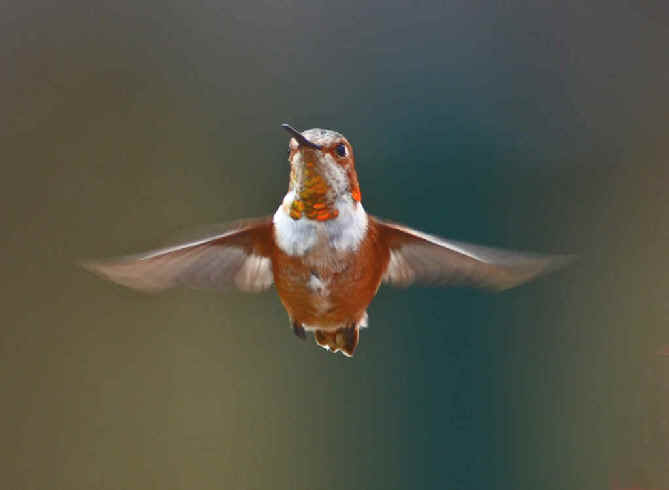
A first-year male ALLEN'S HUMMINGBIRD
(photo by Howard Eskin)
Links:
A List & Photo Gallery of the world's Hummingbirds, in 2 Parts:
Part #1, including: Hermits, Violetears, Mangos, Caribs, Coquettes, Emeralds,
Sapphires, Goldenthroats
Upcoming FONT Birding & Nature Tours
A Directory of Photos in this Website
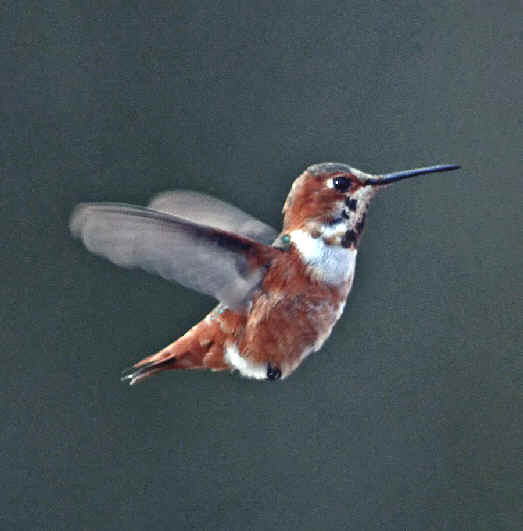
This & the following are two more
photographs
of the same male Allen's Hummingbird
(photos by Howard Eskin,
in Bucks County, Pennsylvania
in November 2012)
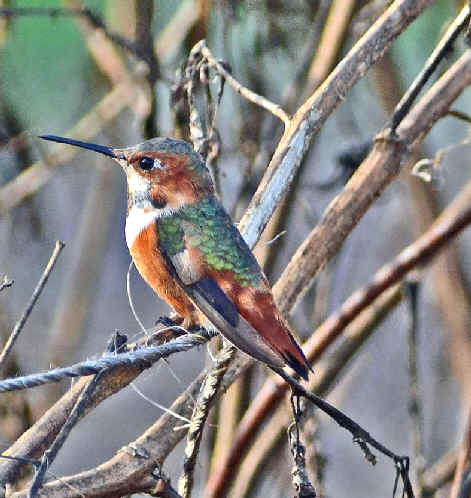
The Allen's Hummingbird, a close relative of
the Rufous Hummingbird, has one of the most restricted breeding ranges of
any North American hummingbird, being confined from the Pacific Coast of
southern California north to southern Oregon. Although its habitat has been
strongly altered by human activity, the bird has adapted well to urban and
suburban environments.
Outside its breeding range, the Allen's Hummingbird is rare, but regular,
in southern Arizona, and has occurred more rarely in New Mexico, west Texas,
Utah, and Nevada. Some winter rarely along the Gulf Coast of the US.
Fall-winter occurrences in eastern US states have been in: Delaware, Florida,
Georgia, Louisiana, Massachusetts, Mississippi, New Jersey, Pennsylvania,
Tennessee, Texas, and Virginia.
In its limited breeding range, there are, as noted above, 2 subspecies. One, sedentarius,
apparently originated on the offshore Channel Islands, and colonized, during the
20th Century, the nearby California mainland. It has recently spread, both north
and south along the coast. Although this subspecies is essentially nonmigratory,
an Allen's Hummingbird specimen from Louisiana has been identified as sedentarius.
The bird in the above 3 photographs was thought to be a Rufous Hummingbird,
but having a notch or emargination in its R5 feather, along with other
characteristics seen during an in-hand inspection, determined it to be a
first-year male Allen's Hummingbird.
![]()
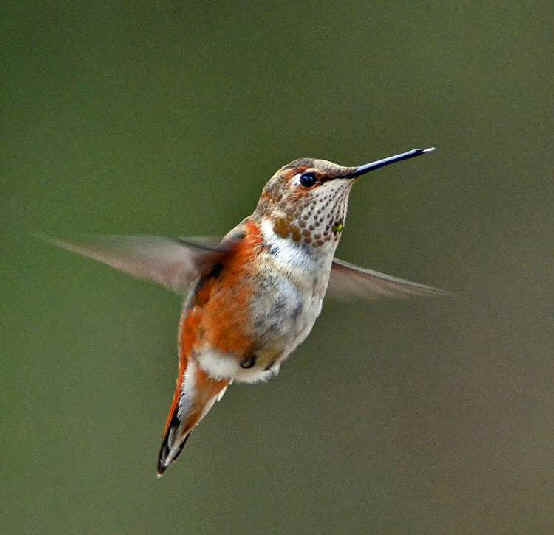
This & the following photo are of
a first-year male Rufous Hummingbird
(photo by Howard Eskin,
in Montgomery County, Pennsylvania,
in November 2012)
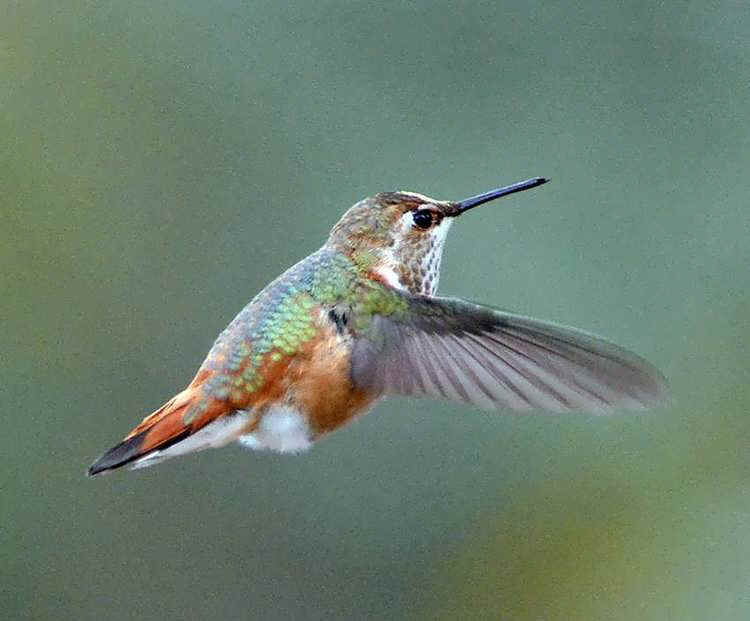
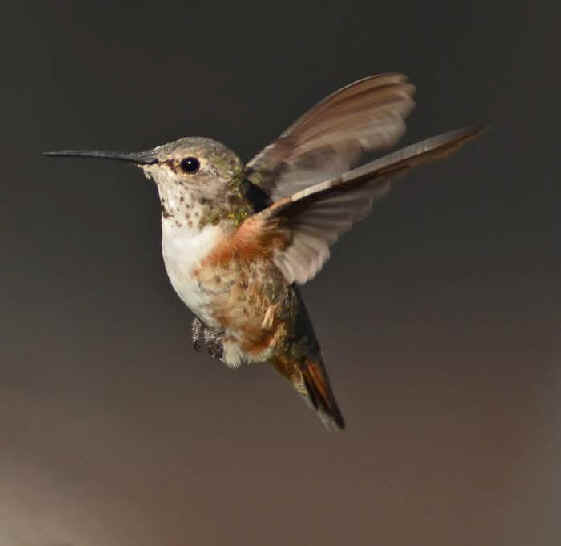
In these two photos, above and below,
an adult female Rufous Hummingbird
(photos by Howard Eskin.
in Montgomery County, Pennsylvania,
in November 2012)
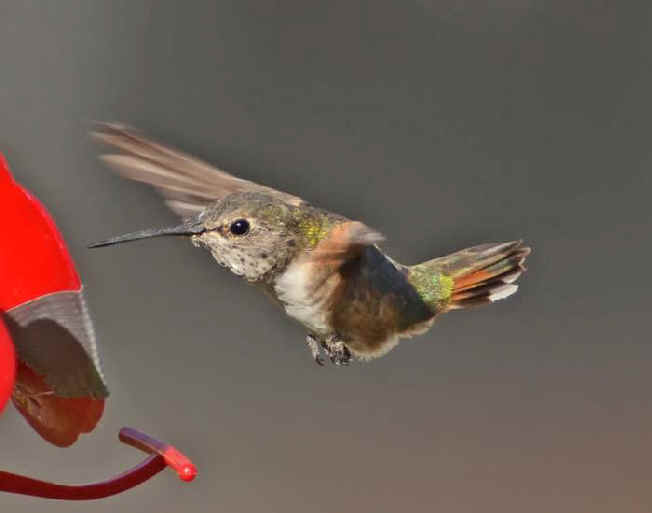
The Rufous Hummingbird is a long-distance
migrant, summering, and breeding, as far north as southern Alaska, and wintering
mostly in Mexico. Some, however, winter in the US, especially in the Southeast
notably along the Gulf Coast, mostly in Louisiana, Mississippi, Alabama, and
Texas. A few also winter in the US in coastal southern California.
The species seems strongly prone to wandering during it southbound migration in
the fall. It has occurred in ALL of the US states east of the Rocky Mountains,
and in most of the Canadian provinces. And so it can appear almost
"anywhere", and is usually discovered at feeders.
In the southbound Rufous Hummingbird migration, adult males travel first,
with adult females following about 1 to 2 weeks later. The migration of the
immature birds is the latest and the most drawn-out, occurring up to a month
after that of the adult female.
The Rufous Hummingbird is the only hummingbird that occurs, on occasion,
in the Old World. In the spring, migratory overshoots have reached as far into
Russian Siberia as the Chukotski Peninsula.
![]()
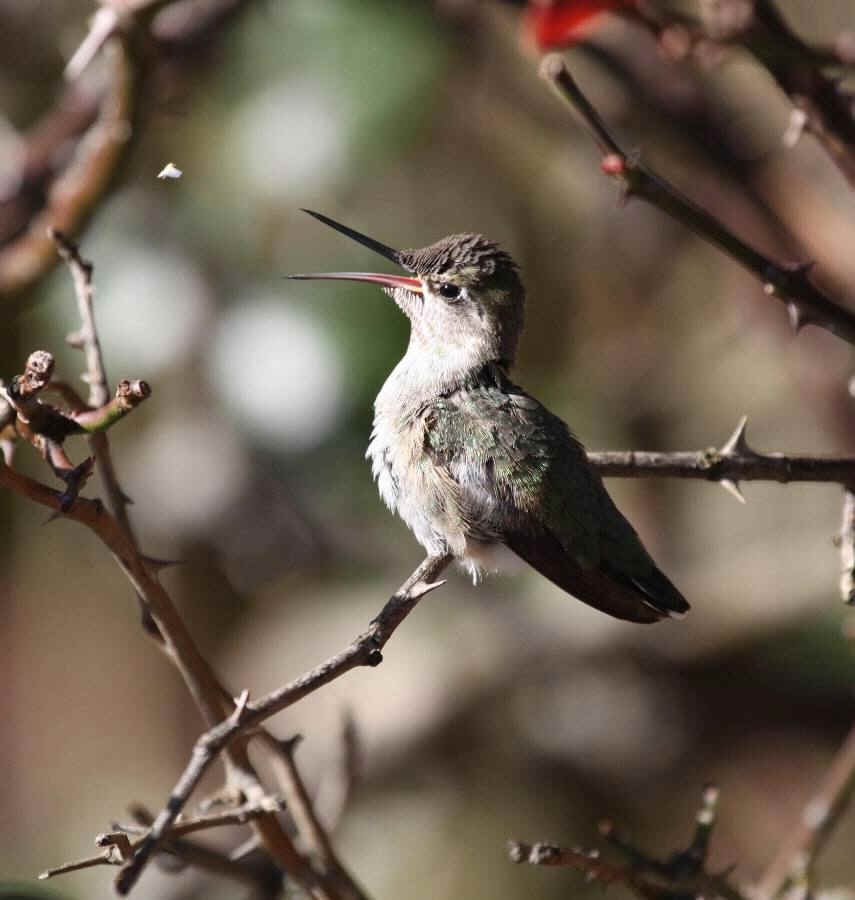
This, and the following 3 photos
are of a young male Anna's Hummingbird.
Above: about to catch an insect,
below: showing its long tongue.
(photos by Marie Gardner,
in Newark, Delaware.
This was the first Anna's Hummingbird
ever in Delaware.)
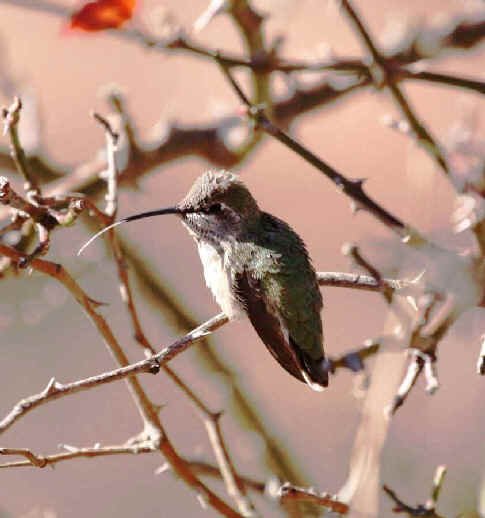
Below, that same Anna's Hummingbird preening.
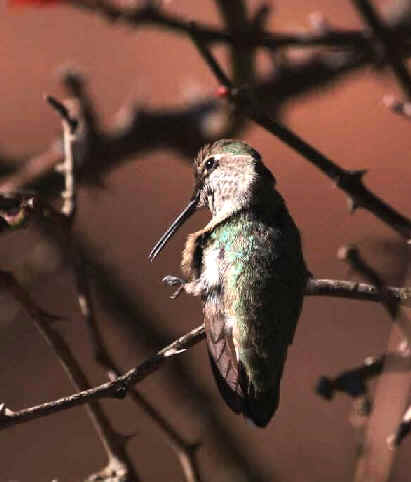
In the photo below of the Delaware Anna's Hummingbird,
some color on the throat is visible.
And in the photo below that, even more color is visible.
The last photograph here was taken about 4 months later than the first.
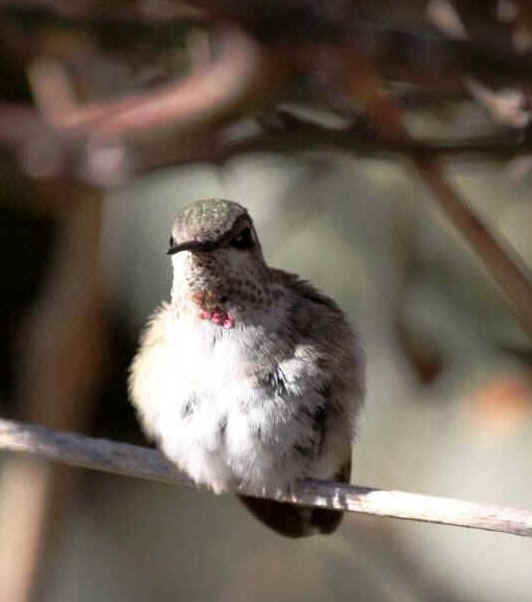
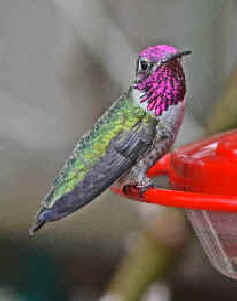
The Anna's Hummingbird in the previous 5
photographs,
that flew from the West Coast to Delaware,
weighed, when it was banded, 3.75 grams.
The Anna's Hummingbird is a species of
western North America, but vagrants can occur almost anywhere, most commonly in
the fall & winter.
Out-of-range occurrences have been in these US states and Canadian provinces:
Alabama (in November), interior Alaska (in September), Alberta (from June to
October), Arkansas (in fall-winter), Colorado (from May to December), Delaware
(in November), Florida (in fall-winter), Georgia (in fall-winter), Idaho (from
September to May), Illinois (in fall-winter), Kansas (in fall-winter), Michigan
(December to April), Minnesota (in fall-winter), Missouri (October to February),
Mississippi (November to January), Montana (June to November), North Carolina
(in fall-winter), New York (October to December), Oklahoma (in winter),
Pennsylvania (in winter), Saskatchewan (from July to October), South
Carolina (in winter), Tennessee (in January), in northern & eastern Texas
(from July to March), Utah (in the fall), Wisconsin (from August to January).
The migration of the Anna's Hummingbird is not well understood. It does
not appear to migrate in the "traditional sense". Year-round presence
is some areas may well be due to breeding birds being replaced by migrants from
other areas.
Large numbers of Anna's in the mountains of Arizona in the non-breeding
season (July to October) have long been assumed to come from California, yet of
the thousands of hummingbirds that have been banded in California and Arizona,
ONLY ONE is has been shown to have traveled between the 2 states!
The breeding range of the Anna's
Hummingbird is in southwestern Canada, the western United States, and
northwestern Mexico. Some birds winter further south in Mexico, and further east
in the southwestern US.
The male Anna's Hummingbird has a remarkable display which
involves a nearly vertical power dive over a display object.
A pinging noise made by the tail and a brilliant display of the iridescent
purple-red feathers of the chin and forehead presumably enhance the display
value of the performance.
This display is given in all months of the year, but is most frequent from
November to April, the breeding season of the species in California. These
hummingbirds are highly territorial and the display dives take place only within
their territorial bounds.
The diving display is as follows:
1. The male climbs nearly vertically, in a hovering flight, with the head bent
downwards and the bill pointed toward the display object so that the male
appears to be eyeing the display object as he ascends.
2. The male stops in mid-air, 100 to 150 feet above and to the side of the
display object. At that point the bird hovers, making no appreciable lateral
movement, so that his azimuth with respect to the display object is no longer
adjustable.
3. Almost at once the male power dives, with a burst of wingbeats, with each
burst terminating with the wings held to the sides. Several power bursts take
place in the downward dive which is made at an angle of perhaps 65 to 75 degrees
from the horizontal.
4. The flight levels at several feet from the display object, and the male
passes over the object almost horizontally.
5. At the moment the bird is over the display object, the tail is lowered, and
by some manipulation, poorly understood, the produces a sharp sound.
6. At that point, the flight is slowed and the bird veers upward, rising in a
hook-shaped course 10 to 15 feet above and beyond the display object, and then
hovers at that position momentarily.
7. He then moves upward again to approximately the same position where the
initial dive started, and a new dive begins.
The number of dives is variable, from one to a dozen or more, but frequently
from three to eight.
The above-described display has been noted to be oriented directly into the
afternoon sun (between about 5:15 & 5:55pm. At times of heavy overcast, the
dives have been seen to be randomly oriented, but with usually little display
activity at such times. Poor weather generally slows the tempo of the display
dive.
Alexander Skutch has distinguished two basically different types of display
among hummingbirds, "dynamic" and "static".
The dynamic type is exemplified by the Anna's Hummingbird display dive
described above,
Also, it is characteristic of the Broad-tailed Hummingbird, the Black-chinned
Hummingbird, Costa's Hummingbird, the Rufous Hummingbird, Allen's
Hummingbird, the Calliope Hummingbird, and the Ruby-throated
Hummingbird - all of these are the most-northerly occurring hummingbirds.
Central American species, such as the Rufous-tailed Hummingbird, White-eared
Hummingbird, and Bumblebee Hummingbird do not have prominent
display dives, but confine their display energy to singing and gorget-flashing
at display posts, thus the static display type.
The above information about the display of the Anna's Hummingbird
and others is from the Wilson Bulletin in March 1965.
![]()

In these 2 photographs, above
& below,
a Calliope Hummingbird,
a species even smaller
than the other hummingbirds here.
(photos by Joe Flood,
at his property in Devon, Pennsylvania,
this bird as the others above
was way out of its normal range
in western North America.
It was in Pennsylvania in late October
& early November in 2012.)
In the photo below, the bird is feeding on Pineapple Sage.
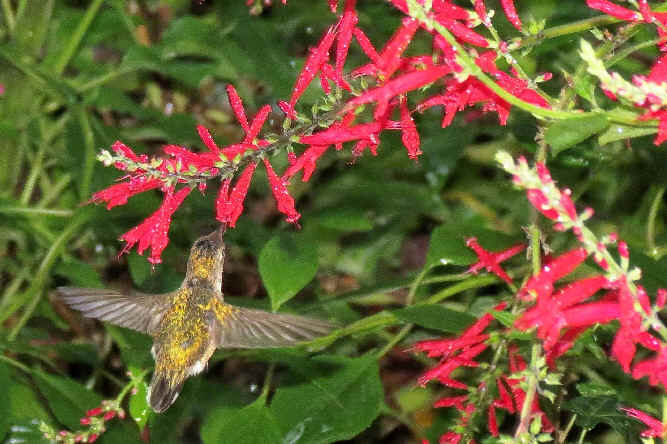
The Calliope Hummingbird
breeds in montane coniferous forests in parts of the western US and southwestern
Canada. Most winter, as noted above, in southwestern Mexico. However, some
winter along the Gulf Coast in the US, from Texas to northwestern Florida,
mainly in Louisiana. More rarely, some winter in west Texas and in Arizona.
Otherwise, vagrants have occurred in these US states and one Canadian province:
northern Alabama (in November), Arkansas (in November & December), central
Florida (in March & April), northern Georgia (in the winter), Kansas (in
July & August), Minnesota (in November & December), North Carolina (from
October to March), Nebraska (from June to August), New Jersey (in November),
Pennsylvania (in November), Saskatchewan (in July & August), South Carolina
(from December to April), South Dakota (in August), Tennessee (from November to
April) and in western & central Texas.
![]()
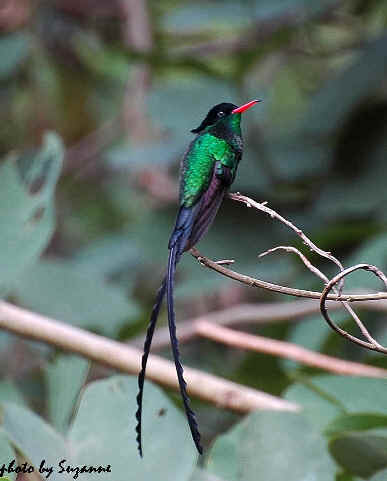
Other hummingbirds photographed in November 2012
included these Red-billed Streamertails in Jamaica.
On that Caribbean island, this species
in locally called the "Doctorbird"
The first two photographs here
are of adult males with long tails.
(photos by Suzanne Bradley)
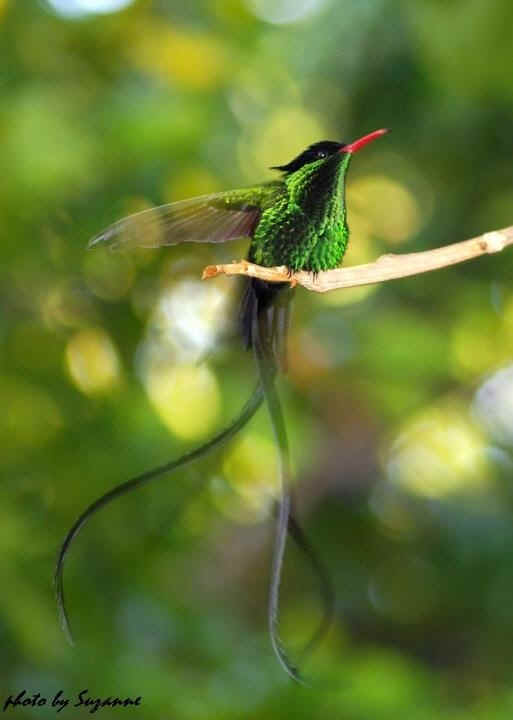
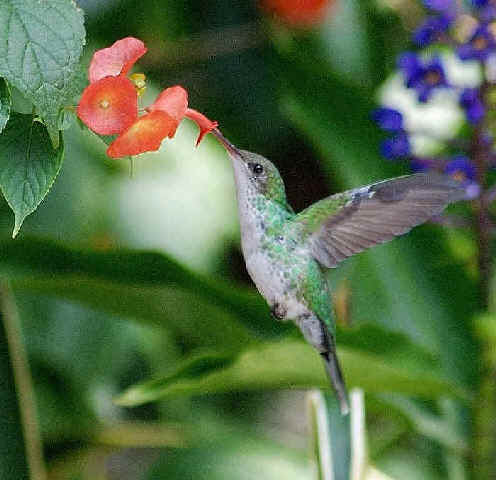
And these two photographs, above & below,
are of female Streamertails.
(photos by Suzanne Bradley)
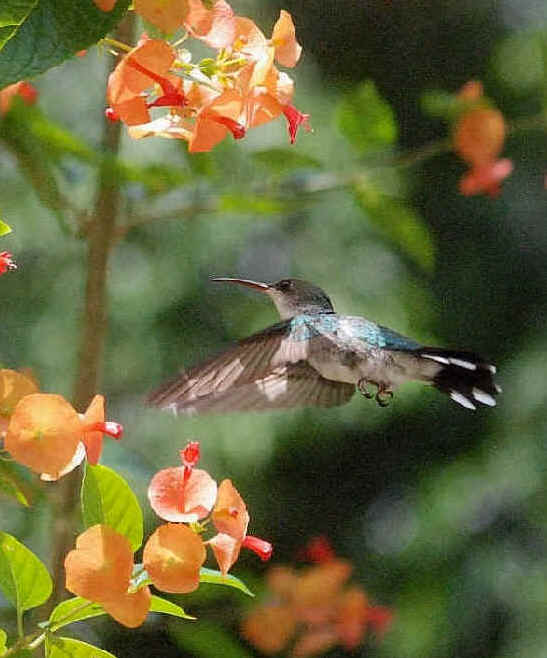
Click here for:
Web page by Rise Hill